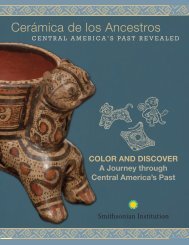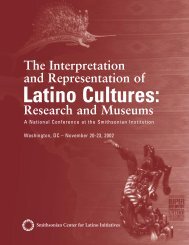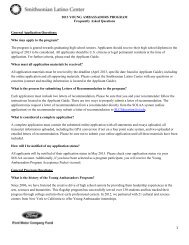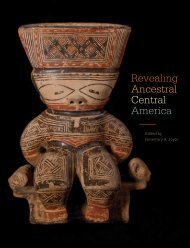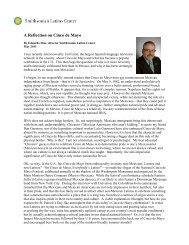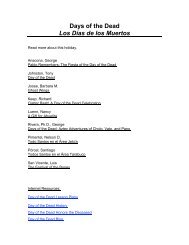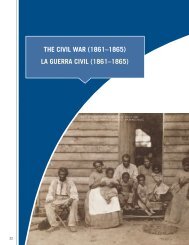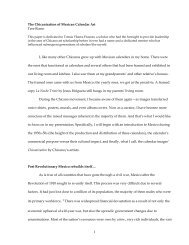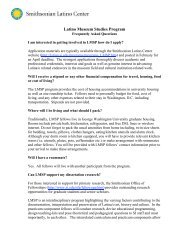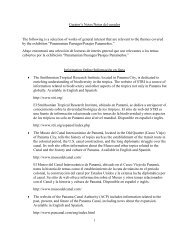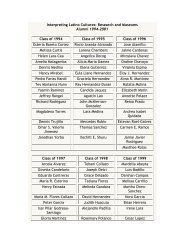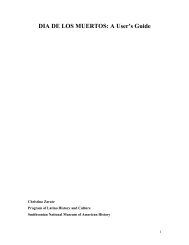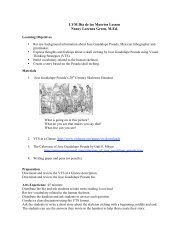smithsonian latino art collections - Smithsonian Latino Center
smithsonian latino art collections - Smithsonian Latino Center
smithsonian latino art collections - Smithsonian Latino Center
Create successful ePaper yourself
Turn your PDF publications into a flip-book with our unique Google optimized e-Paper software.
An Overview of the History of the Exhibitions and Art Collections at the<br />
<strong>Smithsonian</strong> Institution, 1880-2010<br />
Olga Ulloa Herrera<br />
The <strong>Smithsonian</strong> Institution has a history of collecting and exhibiting <strong>Latino</strong>/Hispanic and Latin<br />
American <strong>art</strong> and <strong>art</strong>ifacts that dates back to the 1880s. In a June 2000 report, former National<br />
Museum of American History curator Richard E. Ahlborn wrote about the practices of exhibiting cultural<br />
objects of Spanish/Hispanic and Latin American origins during the last decades of the Nineteenth<br />
Century at the United States National Museum (now the Arts and Industries Building, <strong>Smithsonian</strong><br />
Institution, Washington, DC). 2 According to his own research findings, anthropologists and ethnologists<br />
affiliated with the Institution in the 1880s and 1890s collected Western and Southwest Spanish Catholic<br />
images of santos, carvings and other objects which were on permanent display at the U.S. National<br />
Museum as photographs of the time at the <strong>Smithsonian</strong> Institution Archives tell.<br />
When the U.S. National Museum outgrew its space in the first years of the 20 th century, a new<br />
building on the north side of the National Mall was completed in 1910 to accommodate the expanding<br />
anthropology, <strong>art</strong> and natural history <strong>collections</strong>. Although Hispanic <strong>collections</strong> were on view and<br />
exhibitions of <strong>art</strong>ists from Latin America were organized in the new National Museum’s central skylighted<br />
Art Hall in collaboration with the Pan American Union beginning in 1933, 3 it was not until the late<br />
1940s when ethno-historian John Canfield Ewers and cultural historian C. Malcolm Watkins joined the<br />
institution as associate curators of ethnology, that the <strong>Smithsonian</strong> Institution st<strong>art</strong>ed to actively acquire<br />
and develop Hispanic <strong>collections</strong> related to their areas of expertise on the history of the American Indian<br />
of the West 4 and American material culture, technology and decorative <strong>art</strong>s, respectively 5 .<br />
In the early 1950s the focus of collecting expanded to the Americas as Ewers became involved in<br />
the Institution’s Exhibits Modernization Program, which called for the redesign and redevelopment of<br />
exhibition halls, in p<strong>art</strong>icular Hall 9 and Hall 11, which were to be dedicated to New World ethnology.<br />
The new configuration and arrangement of wall cases and miniature dioramas, according to Ewers,<br />
“provide[d] an ordered, graphic interpretation of the ethnology of the Native Peoples of the New World,<br />
from the Polar Eskimo to the Indians of Tierra de Fuego.” 6 One such cases dedicated to Pueblo Religious<br />
Ceremonialism/Christianity and Pueblo Indians featured, according to Alhborn, “a fine leather painting<br />
and wood work by Hispanic New Mexicans.” 7 Also under the Exhibits Modernization Program, in 1957<br />
Watkins in turn organized the first large exhibit on everyday life in colonial and federal United States. 8<br />
In the late 1950s the Institution underwent a new period of expansion with the proposed<br />
Museum of History and Technology, which was conceptualized and created in 1958. Ewers joined it as<br />
its new administrative officer while Watkins became head of its new Division of Cultural History in the<br />
Dep<strong>art</strong>ment of Civil History.<br />
2 Richard E. Ahlborn. “Exhibits at the <strong>Smithsonian</strong> with ‘<strong>Latino</strong>’ Artifacts.” 23 October 2000. Author’s archive.<br />
3 For a list of exhibitions of Latin American Art, see “Notes on Latin American Exhibitions from 1933-1946.”<br />
<strong>Smithsonian</strong> Institution Archives, Record Unit 311, Box 42, Folder 2.<br />
4 Margaret R. Dittmore. “John C. Ewers,” February 9, 1999.<br />
http://www.sil.si.edu/DigitalCollections/BAE/Bulletin1964/ewersbio.htm accessed 1 August 2011.<br />
5 <strong>Smithsonian</strong> Institution Archives, C. Malcolm Watkins Papers, 1935-1979 and undated. Historical Note.<br />
http://siarchives.si.edu/findingaids/faru7322.htm accessed 1 August 2011.<br />
6 John C. Ewers, “Problems and Procedures in Modernizing Ethnological Exhibits.” American Anthropologist, Vol.<br />
57, No. 1 (Feb. 1955): 2.<br />
7 Alhborn, 2000, p. 1. Also see, Ewers, 1955: 11.<br />
8 <strong>Smithsonian</strong> Institution Archives, C. Malcolm Watkins Papers, Historical Note.<br />
7



